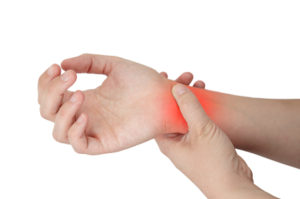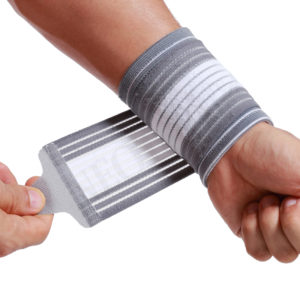[Disclosure: This post may contain some affiliate links. Meaning: If you would decide to make a purchase through those links, we would get a commission (at no costs to you)]

Are you at a higher risk of developing carpal tunnel syndrome ? Have you ever suffered arthritis? Do you have high blood pressure or diabetes? Is your job involved repetitive wrist movement, include manufacturing, assembly line work, keyboarding occupations, and construction work? In this article we will talk about causes and treatments of carpal tunnel syndrome.
Carpal Tunnel Syndrome – What is it?
Carpal tunnel syndrome is numbness, tingling, weakness, and other problems in your thumb and first three fingers of your hand because of pressure on the median nerve in your wrist. The median nerve and several tendons run from your forearm to your hand through a small space in your wrist called the carpal tunnel. The median nerve controls movement and feeling in your thumb and first three fingers (not your little finger).
Carpal Tunnel Syndrome – Causes
Carpal tunnel syndrome occurs when a combination of health conditions and activities puts pressure on the median nerve as it passes through the carpal tunnel in your wrist. This pressure leads to symptoms. Anything that decreases the amount of space in the carpal tunnel, increases the amount of tissue in the tunnel, or increases the sensitivity of the median nerve can lead to carpal tunnel syndrome.
Things that help cause carpal tunnel syndrome include:
- Diabetes
- Obesity
- Thyroid dysfunction
- Fluid retention from pregnancy or menopause
- High blood pressure
- Autoimmune disorders such as rheumatoid arthritis
- Broken wrist bones, dislocated bones or bone spurs
- Fractures or trauma to the wrist
Carpal tunnel syndrome is a common work-related condition. It also can be caused by work that requires:
- Forceful or repetitive hand movements
- Hand-arm vibration
- Working for long periods in the same or awkward positions
- Keyboarding occupations
- Construction work
Carpal Tunnel Syndrome – Treatment
The goal of treatment for carpal tunnel syndrome is to allow you to return to your normal function and activities and to prevent nerve damage and loss of muscle strength in your fingers and hand. Treatment options for carpal tunnel syndrome include: home treatment, exercise, medication and surgery, depends on how severe your pain and symptoms are and if there is weakness.
Home treatment
- Rest your fingers, hand, and wrist. Stop activities that you think may be causing numbness and pain.
- Use an ice pack* to ice your wrist for 10 to 15 minutes at a time, once or twice an hour.
- Wear a wrist brace* at night to keep your wrist in a neutral position and relieve pressure on your median nerve.
Exercise
When your pain is gone, ask your doctor information about exercises for building flexibility and strength in your hand, wrist, and arm.
- Rotating your wrist up, down, and from side to side.
- Stretching your fingers far apart, then relaxing them, then stretching them again.
- Stretching your thumb by pulling it back gently, holding it, and then releasing it.
- Squeezing a rubber ball.
- Wrist curls and extensions with a light weight.
If any exercise or motion causes pain or swelling, stop that exercise, or reduce the intensity or amount of motion.
Medication
Nonsteroidal anti-inflammatory drugs (NSAIDs) may relieve pain and inflammation and are available with or without a prescription.
Surgery
Surgery is sometimes recommended when other treatment hasn’t helped, if you’ve had carpal tunnel syndrome for a long time, or if there is nerve damage or the risk of nerve damage.
Treatment for carpal tunnel syndrome is based on the seriousness of the condition, whether there is any nerve damage, and whether other treatment has helped. If your symptoms are mild, 1 to 2 weeks of home treatment are likely to relieve your symptoms.
Carpal Tunnel Syndrome – Prevention
To help prevent carpal tunnel syndrome:
- Take good care of your general health. This includes staying at a healthy weight, not smoking, and getting regular exercise.
- Keep your arm, hand, and finger muscles strong and flexible.
- Stop any activity that you think may be causing finger, hand, or wrist numbness or pain.
- Use hand and wrist movements that spread the pressure and motion evenly throughout your hand and wrist. For example, keep your wrists straight or only slightly bent. Avoid activities that bend or twist the wrists for long periods of time.
- Switch hands and change positions often when you are doing repeated motions. Take breaks, and rest your hands.
- Use correct posture.
- Restrict your salt intake if you tend to retain fluid.
- Wear a wrist brace* when you cannot control your wrist motion, such as while sleeping. A brace can keep your wrist in a neutral position-that is, not bent too far forward or back-and reduce the stress on your fingers, hand, or wrist.
In daily routines at home or while doing hobbies, think about changing activities in which you make repeated finger, hand, or wrist movements. Train yourself to use other positions or techniques that won’t stress your hand or wrist.
*affiliate link
18 Responses
types of massage
I loved your post ! I read your blog fairly often and you always come up with gret stuff
! I shared this on my Facebook and my followers
loved it ! Keep up the good work !
Neotech Care
Hi, thank you for your comment! We will talk more about back pain, joint health and exercises to keep healthy in the future. You can also find us on Facebook(https://www.facebook.com/steadyjoints/) and Twitter(https://twitter.com/steadyjoints) for more tips!
best portable construction generator
you are in point of fact a excellent webmaster. The site loading velocity is incredible. It sort of feels that you are doing any unique trick. Also, The contents are masterwork. you’ve performed a excellent activity in this matter!
Neotech Care
Hi, thank you so much for your comment! We will talk more about back pain, joint health and exercises to keep healthy in the future. You can also find us on Facebook(https://www.facebook.com/steadyjoints/) and Twitter(https://twitter.com/steadyjoints) for more tips!
Yacon Root Extract
I take pleasure in reading through your blog site. It was Quite thrilling. 🙂
Neotech Care
Hi, thank you so much for your comment! We will talk more about back pain, joint health and exercises to keep healthy in the future. You can also find us on Facebook(https://www.facebook.com/steadyjoints/) and Twitter(https://twitter.com/steadyjoints) for more tips!
mua ngay
Hey very interesting blog!
Neotech Care
Hi, thank you for dropping by, I’m so glad that you like our post! We will talk more about back pain, joint health and exercises to keep healthy in the future. You can also find us on Facebook(https://www.facebook.com/steadyjoints/) and Twitter(https://twitter.com/steadyjoints) for more tips!
Kelly
Wow! After all I got a webpage from where I know how to in fact get
valuable facts regarding my study and knowledge.
Neotech Care
Hi, thank you for dropping by, I’m so glad that you like our post! We will talk more about back pain, joint health and exercises to keep healthy in the future. You can also find us on Facebook(https://www.facebook.com/steadyjoints/) and Twitter(https://twitter.com/steadyjoints) for more tips!
Iva
Great site. Just had a quick read.
Neotech Care
Hi, thank you for dropping by, I’m so glad that you like our post! We will talk more about back pain, joint health and exercises to keep healthy in the future. You can also find us on Facebook(https://www.facebook.com/steadyjoints/) and Twitter(https://twitter.com/steadyjoints) for more tips!
can you stop high blood pressure medication
Good post however I was wondering if you could write a litte
more on this
subject? I’d be very thankful if you could elaborate a
little bit
further. Many thanks!
Neotech Care
Hi, thank you for stopping by, I’m so glad that you like our post! We will talk more about back pain, joint health and exercises to keep healthy in the future. You can also find us on Facebook(https://www.facebook.com/steadyjoints/) and Twitter(https://twitter.com/steadyjoints) for more tips!
Laserschneidemaschine
A person essentially help to make seriously articles I would state. This is the very first time I frequented your website page and thus far? I surprised with the research you made to create this particular publish incredible. Fantastic job!
Neotech Care
Hi, thank you for stopping by, I’m so glad that you like our post! We will talk more about back pain, joint health and exercises to keep healthy in the future. You can also find us on Facebook(https://www.facebook.com/steadyjoints/) and Twitter(https://twitter.com/steadyjoints) for more tips!
Sunbun
Hey just wanted to give you a quick heads up. The words in your post seem to be running off the screen in Chrome. I’m not sure if this is a format issue or something to do with web browser compatibility but I thought I’d post to let you know. The design look great though! Hope you get the problem fixed soon. Many thanks
Neotech Care
Hi, thank you for stopping by and your comment! We always double check our posts before posting, so maybe it is not a format issue. Sometimes change a browser would be help. We will talk more about back pain, joint health and exercises to keep healthy in the future. You can also find us on Facebook(https://www.facebook.com/steadyjoints/) and Twitter(https://twitter.com/steadyjoints) for more tips!